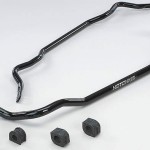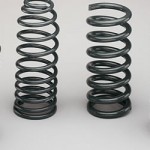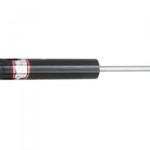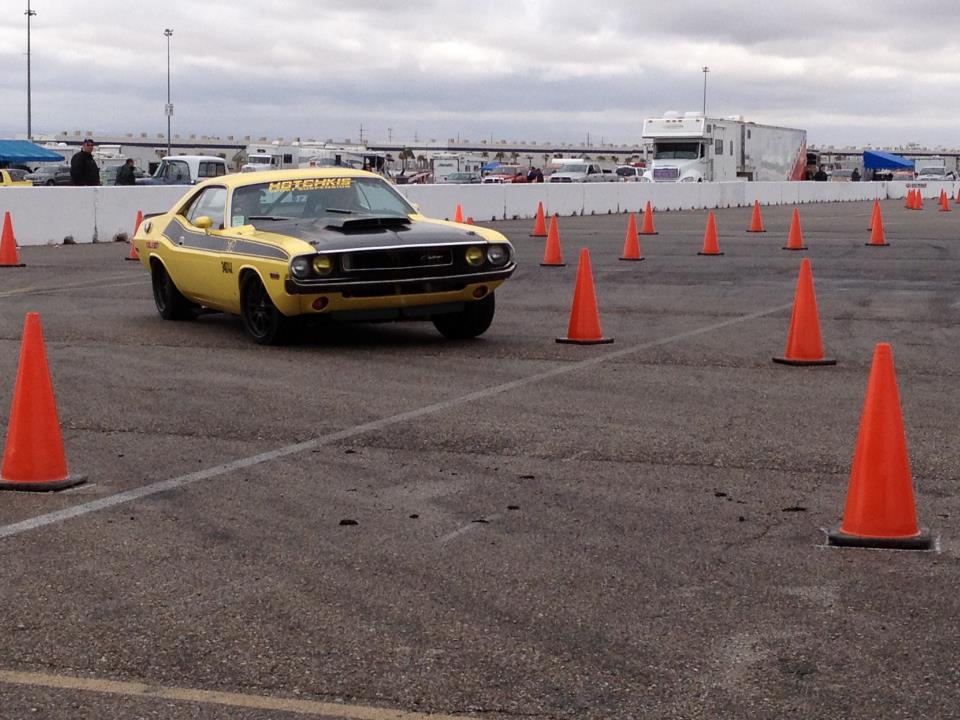The American muscle car is synonymous with brute power, tire-shredding torque, and—well, muscle. Things like handling, cornering, and ride comfort tend to be an afterthought in our pursuit of the almighty horsepower. Luckily, companies like BMR Suspension, Hotchkis Sport Suspension, and others are focused on making sway bars, lowering springs, performance shocks, and other suspension components that allow you to fully flex your car’s muscle without compromising handling and ride comfort.
In our Suspension 101 post, we went over the components that make up an automotive suspension system and talked about aftermarket upgrades that can make it better. Now, with help from the experts at Hotchkis Sport Suspension and BMR Suspension, we’ve put together the five essential suspension upgrades that will help your muscle car handle.
 Sway Bars
Sway Bars
Although there is some debate among suspension manufacturers about where to begin a handling upgrade, we’ll start with sway bars (also commonly called anti-sway bars, antiroll bars, or stabilizer bars). Sway bars reduce body roll—the dramatic transfer of weight to your outside wheels during a sudden, hard turn—by tying together the left and right sides of your vehicle’s suspension. As your vehicle enters a tight turn, sway bars absorb the cornering load, reducing body roll in the process.
Most 1960s- and 70s-era muscle cars came with a very small front sway bar and no rear bar at all.
“Factory 14 x 6 bias-ply tires would lose traction long before the suspension was maxed out, so a small bar was all you needed,” said Mark Rossetti, sales manager at Hotchkis Suspension. “In this era of high performance radial tires with sticky compounds, upgrading to a larger, high performance sway bar is one of the fastest, easiest, and most cost-effective ways to improve handling and control on your muscle car.”
The two most important criteria in choosing a sway bar are the cross-section (diameter and wall thickness) and the distance between the end link and rotation point on the bar, according to Alan Miller, president of BMR Suspension. These two factors affect the sway bar’s overall stiffness and its ability to absorb the cornering load. One of the most common mistakes is to upgrade to the biggest diameter sway bar possible.
“When you change your sway bar, you’re affecting understeer and oversteer, too,” Miller said. “A sway bar can reduce or eliminate over or understeer problems on certain vehicles, but the wrong size can also create or overcorrect the problem. Remember, the closer to neutral steer you are, the better grip your car will have on the street.”
Another common mistake, according to Miller, is to assume that solid bars are better than hollow designs. To the contrary, many sway bar manufacturers are switching to hollow construction on most diameter sizes.
“We compared a one-inch hollow sway bar with a one-inch solid bar on an F-150,” Miller said. “It only affected the overall sway bar rate by three percent but gave us a 50-percent weight savings.”
Springs
Springs come in many forms: coil springs, leaf springs, torsion bars, or air bags. The main job of the springs is to support the weight of your vehicle and absorb shock from the road. Spring stiffness also plays a role in determining how much body roll your vehicle experiences.
Whether you have a stock leaf spring suspension—still found on many of today’s trucks—or a coil spring setup, you can affect your vehicle’s handing by adding a set of lowered coil or leaf springs with the proper spring rate. According to Miller, lowering springs should be one of the very first upgrades—if not the first upgrade—you consider.
“Just the fact you’re lowering the center of your vehicle’s gravity goes a long way toward reducing body roll,” Miller said. “It’s just natural physics. Plus, as an added bonus, a good set of lowering springs will often improve the overall outward appearance of a vehicle, too.”
Spring rate is the key factor in choosing the proper spring for your vehicle. Spring rate is the amount of force it takes to compress the spring one inch. Soft springs (with low spring rates) will generally preserve ride quality but offer less body roll control than springs with stiffer rates. Stiffer springs (high spring rates) will reduce body roll but may provide a harsher ride. So should you choose a soft or a stiff spring rate?
Optimum spring rate depends on a variety of factors, including your driving habits, vehicle, and other suspension components. If you use a larger diameter sway bar, for example, you can often opt for a softer spring rate. Conversely, a smaller diameter sway bar will often work well in tandem with stiffer springs.
“My recommendation is to start with as stiff a spring as possible without compromising the overall drivability of the car,” Miller said. “If you go with too stiff a spring, your car may start to drive more like a truck. Remember, you can always add an aftermarket sway bar to further eliminate body roll. Springs and sway bars work well in tandem.”
 Many aftermarket suspension manufacturers also offer progressive-rate springs. Unlike standard, linear-rate springs, which require uniform pressure to compress the spring every inch, progressive-rate springs require progressively more force to compress the spring each additional inch. This allows progressive-rate springs to offer softer initial spring rates for good ride quality under normal conditions and stiffer rates as they’re compressed during cornering. As a result, progressive-rate springs are a popular option for street performance. However, critics of progressive-rate springs point out that the variable rates make it more difficult to match or dial-in other suspension components such as shocks.
Many aftermarket suspension manufacturers also offer progressive-rate springs. Unlike standard, linear-rate springs, which require uniform pressure to compress the spring every inch, progressive-rate springs require progressively more force to compress the spring each additional inch. This allows progressive-rate springs to offer softer initial spring rates for good ride quality under normal conditions and stiffer rates as they’re compressed during cornering. As a result, progressive-rate springs are a popular option for street performance. However, critics of progressive-rate springs point out that the variable rates make it more difficult to match or dial-in other suspension components such as shocks.
Your suspension manufacturer or Summit Racing tech rep can help you match the proper spring rate to your vehicle, sway bar, and shocks. Many manufacturers offer spring/sway bar packages, which include springs, sway bars, and shocks that have been tested and tuned to work with one another.
Shocks
Contrary to popular belief, springs actually support the weight of your vehicle and absorb shock from the road. So what, then, do shock absorbers do?
 Shock absorbers are charged with damping the motion of the springs, preventing them from endlessly bouncing in response to every change in road condition. By changing the valving of your shocks you can control the damping rate and optimize the rate of weight transfer for better handling.
Shock absorbers are charged with damping the motion of the springs, preventing them from endlessly bouncing in response to every change in road condition. By changing the valving of your shocks you can control the damping rate and optimize the rate of weight transfer for better handling.
“Nothing available over the counter at your local auto parts store is a true performance shock—despite what it might say on the box,” Rossetti said. “Shocks offered by Hotchkis and other aftermarket manufacturers offer tuned performance that combines a decent ride with excellent balance and control.”
Adjustable shocks allow you to achieve ideal valving for your combination of suspension components. In addition, many aftermarket shocks feature velocity-sensitive valving, which allows the shock to automatically adjust to changing road conditions.
“Shocks are truly one of those things where you get what you pay for,” Miller said. “Shocks need to be matched to the spring rate, and adjustable-rate shocks allow you to tune each corner of your suspension for optimum weight transfer. Best case is a double-adjustable shock.”
Tires
OK—so tires aren’t exactly a real suspension component. But for the purposes of handling and cornering, we’re making them an honorary member of our family of suspension components. As the final connecting point between your vehicle and the road, we’d argue that a good set of tires are as essential to handling as any other component.
Consider upgrading your tires to something with a greater tread surface area to maintain a larger contact patch with the road. Be sure to select a high performance tread design to maintain maximum, corner-carving grip.
Control Arms
Most 1960s-era muscle cars were designed with bias-ply tires in mind, but modern radial tires require different suspension geometry to allow your suspension to operate at its peak potential. Aftermarket tubular control arms will allow you to achieve just the right negative camber to achieve optimum suspension geometry.
Camber, which is the vertical angle of the tire in relation to the road surface, has a direct effect on two important aspects: tire contact patch and tire wear. With negative camber, the tops of your tires are angled more inward than the bottom, allowing the tires to maintain a greater contact patch with the road during cornering. However, too much negative camber can lead to premature tire wear and reduced tire life, so it’s important to create just the right suspension geometry.
“Often enthusiasts install wider, larger diameter wheel/tire packages and notice their car feels uncontrollable at times,” Rossetti said. “Properly engineered tubular control arms will increase caster, which offers added vehicle stability, as well as improved camber curve which helps tire clearance and allows the tire to keep a bigger contact patch on the ground throughout the turn. This improves both traction and overall handling.”
Performance is in the eye of the beholder—whether we see it on dyno sheets, time slips, or our speedometer. But performance can also be measured by what we feel—responsive handling, tight cornering, and a smooth ride. Thanks to our five key suspension components, you can have it all.


[…] Suspension 201: 5 Ways to Improve Your Muscle Car’s Handling […]